The greatest British political cartoon of all time
What was the Greatest British Political Cartoon of All Time?
Over the past few hundred years, cartoonists in Britain have, on occasions, produced drawings that have not only encapsulated significant historical events but have over time become iconic. No other medium, written or visual, comes close to capturing moments in history more than the great political cartoon. This is all the more impressive, when you consider that cartoonists have to interpret events as they are happening, without the benefit of hindsight or the time for in-depth research. Anyone who has studied history at secondary school level must have noticed the many outstanding cartoons in history textbooks and journals such as History Today over the past fifty years. As a consequence, if you ask anyone with an interest in history or politics to name one of these famous cartoons, they will most likely mention several. Although they may not be able to name the cartoonist, the cartoon’s caption or where it was originally published, they will be able to describe it. The imagery and composition of Gillray’s ‘Plum Pudding’, Zec’s ‘Here you are! Don’t lose it again!’ or Low’s ‘Rendezvous’ have become over the years, part of our common consciousness. Nowhere else in the world does the cartoon have such an impact: it is far easier to list the ten greatest cartoons published in Britain than to name ten equivalent great ones from anywhere else in the world. In America, besides the Thomas Nast cartoon of ‘Boss Tweed’, the vast majority of American historians would struggle to name another, even from the twentieth century. The quality and depth of political caricature in Britain has a unique heritage which remains to this day far superior to that of the rest of the world.
What makes a great cartoon? I would say it is where the cartoonist has combined outstanding draftsmanship with an ability to comment on an event or situation in a vivid, perceptive and imaginative way. This can be done either satirically or, for dramatic effect, poignantly. The composition is also essential for ease of interpretation and appreciation. The dynamics of composition can also help heighten the cartoon’s impact. With each of my top ten cartoons, complex events have been transformed into simple patterns of black and white. Each cartoon, like the picture, as the old adage goes, paints a thousand words.
Through the years British political cartoonists themselves, have facilitated the memory of the great cartoon by their tradition of alluding to previous ‘classics’. Sir John Tenniel’s ‘Dropping the Pilot’ cartoon for Punch (1890) was the first example of a cartoon to be alluded to by other cartoonists. Most of my top ten have since been regularly alluded to by cartoonists. Today, allusions are still popular, especially with the likes of Nick Garland of the Daily Telegraph, Steve Bell of the Guardian and Dave Brown of the Independent. The use of allusion by the cartoonist and of the words ‘with apologies to... ’ helps keep classic cartoons in the reader’s mind and recognizes the original cartoon’s greatness, imitation being the sincerest form of flattery. This is in no sense copying, for the modern cartoonist is producing an updated version of a memorable image, and one that makes a similar point as the original but refers to a contemporary issue. The composition remains roughly the same but the characters or the captions are brought up to date. For example, Nick Garland’s homage to David Low’s ‘Rendezvous’ (which appeared in the Daily Telegraph on March 2nd, 1983) has not Stalin and Hitler greeting each other over the body of a dead Polish soldier, but Thatcher and Foot meeting over the body of the dead SDP. Les Gibbard’s homage to Zec’s famous ‘Price of Petrol’ was published in the Guardian on May 6th, 1982. It is identical to Zec’s original, but Gibbard had slightly changed the title to make a point on the sinking of the Belgrano during the Falklands War. This cartoon almost caused as much stir as the original: the next day Gibbard was labelled a traitor in the Sun’s leader column.
Paradoxically, Winston Churchill, easily the most caricatured politician of all time, does not appear in any of the ten cartoons I have selected. Only in three of them do we have the prime minister of the day (William Pitt, Lloyd George and Harold Macmillan). Representational figures commonly used in editorial cartooning appear in half of those selected: thus Raven-Hill uses the popular symbol of America, Uncle Sam, while both of Zec’s have the heroic image of a British serviceman – in the guise of a merchant seaman in the first instance and as a soldier in the second. Bairnsfather’s includes a character he had created by the name of Old Bill to represent the average ‘Tommy’. Strube includes the most famous everyman figure ever, the ‘Little Man’ who so successfully represented the average man in the street during the 1920s and 30s. Only Raven- Hill’s ‘The Gap in the Bridge’, Low’s ‘Rendezvous’ and Tenniel’s ‘Dropping the Pilot’ exclude any British political involvement. With the Daily Mirror's two Philip Zec cartoons, I found it impossible to leave either out and, uniquely, they both made history in their own right. I have not included the work of living cartoonists, of which there are many fine examples. For simplicity, I have listed my choice of the ten greatest cartoons in chronological order.
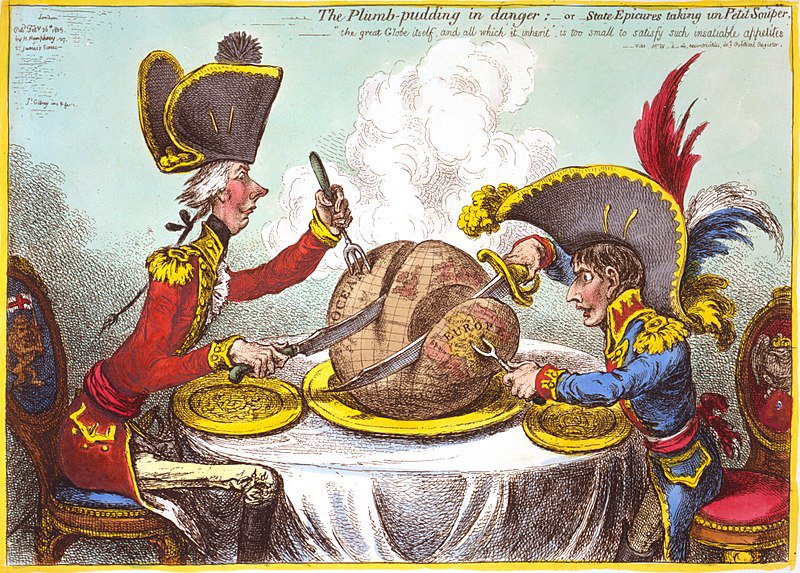
1) James Gillray Plum Pudding in Danger’ 1805; Print
This, the greatest of the many cartoons by Gillray, shows Prime Minister William Pitt and the French Emperor Napoleon Bonaparte gleefully carving up the globe between them, albeit ‘too small to satisfy such insatiable appetites’. Pitt is seen taking the ocean, while Napoleon takes Europe, without the faintest hint of any moral difference between them. This cartoon is based on Napoleon’s unofficial peace offer to George III in January 1805. Despite this apparently cynical image of a British prime minister colluding with the Fench emperor, Napoleon’s overtures were immediately rebuffed by the British who made it clear that they would prosecute the war against the French with ‘vigour’.
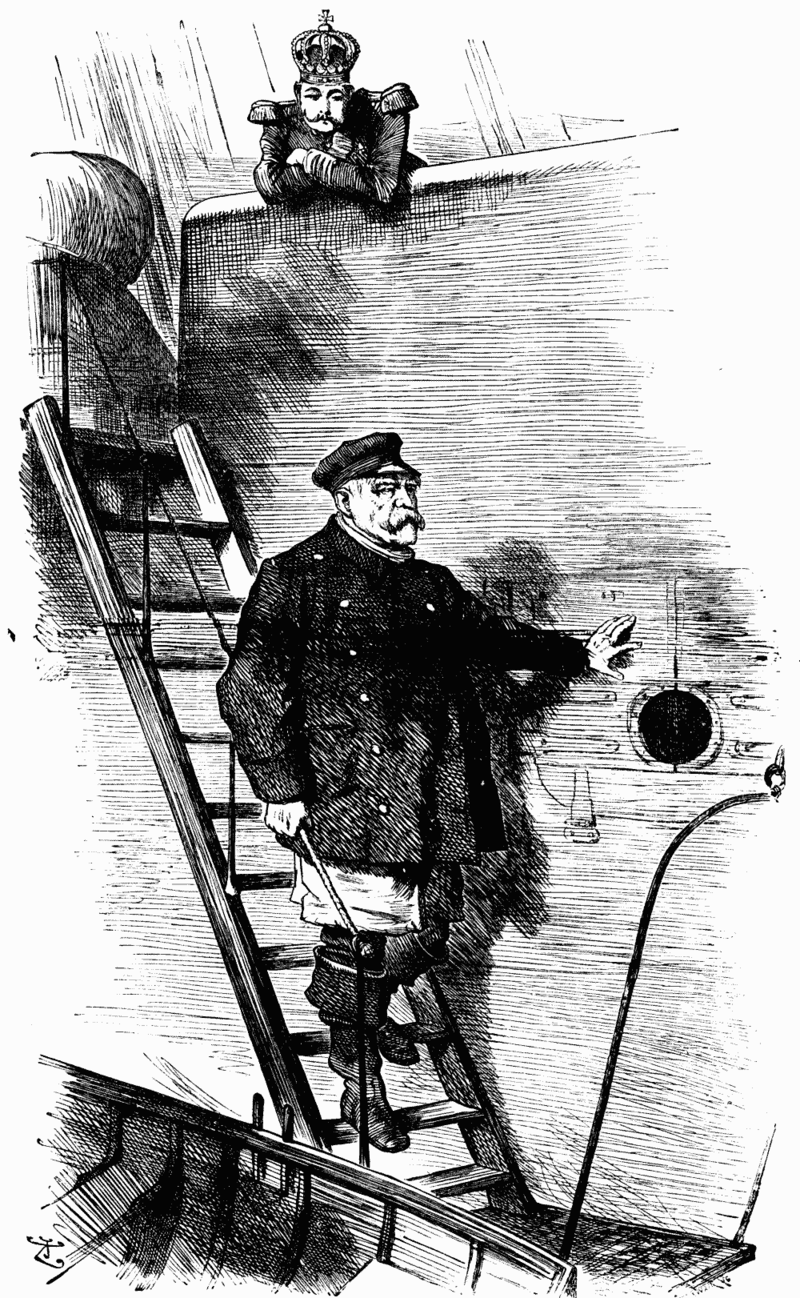
2) Sir John Tenniel ‘Dropping the Pilot’ March 29th, 1890; Punch
Sir John Tenniel is best known for supplying the illustrations to Alice in Wonderland. Yet his ‘Dropping the Pilot’, which marks the resignation of the German chancellor Bismarck, is probably the best- known of the thousands of cartoons from Punch published in that magazine’s 150-year history. In 1890, Bismarck tendered his resignation to the Emperor Wilhelm, but phrased it in such a way as to make it clear that he had done so under sufferance. The consequences of the dismissal of Bismarck were disastrous. Wilhelm’s rejection of Bismarck’s sophisticated approach to foreign policy eventually resulted in war against Britain, France and Russia in August 1914.
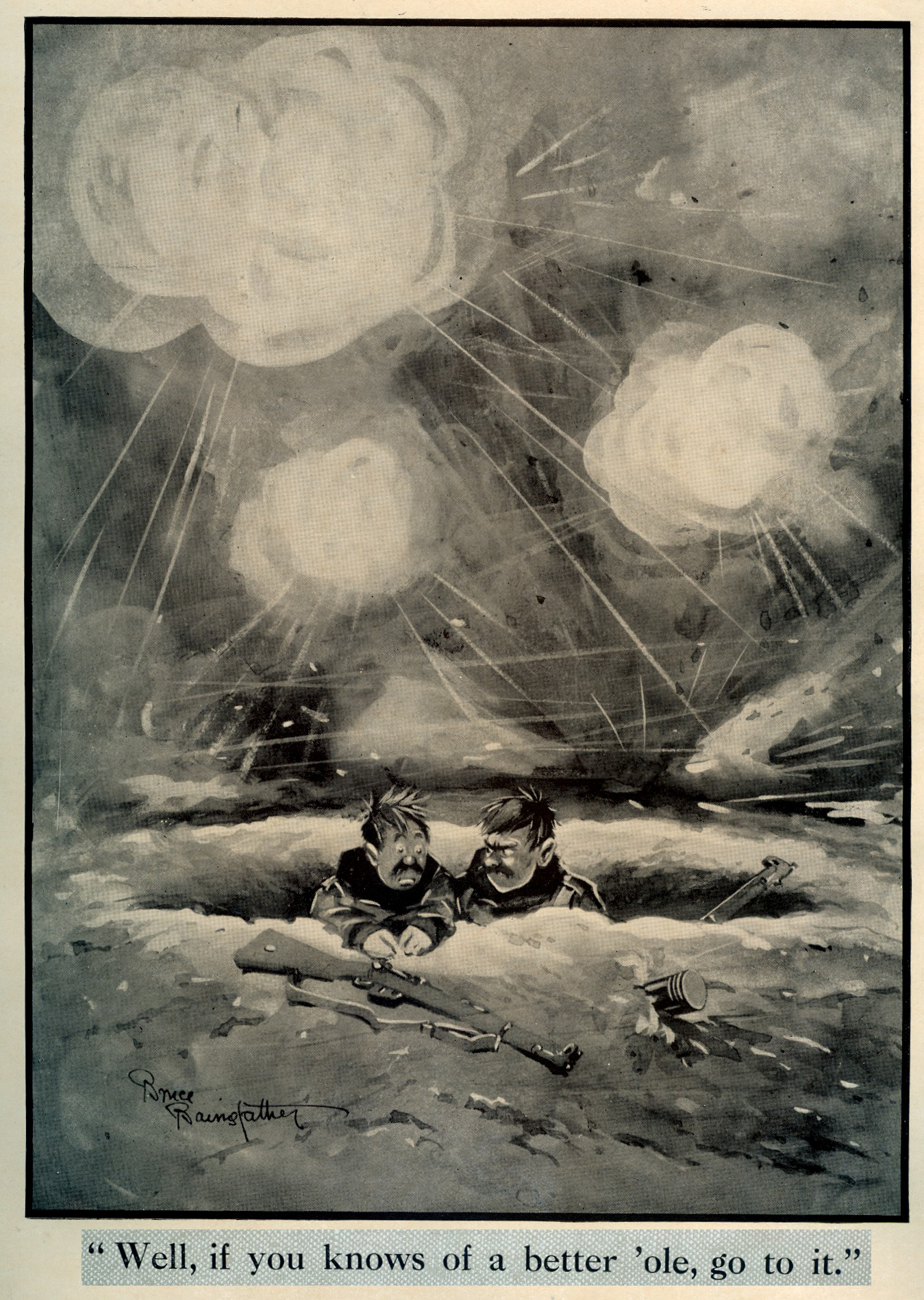
3) Bruce Bairnsfather ‘Well, If you knows of a better ’ole, Go to it’ November 24th, 1915; The Bystander
Although Bruce Bairnsfather’s commentary on the Western Front is not as well known as the work of the poet Wilfred Owen, his depictions of the horrors of the First World War struck a chord with thousands of British soldiers. As well as images of grim reality, he reflected the unbelievable humour and strong morale that existed between the men. In fact, General Sir Ian Hamilton described Bairnsfather as ‘the man who won the war’. Bairnsfather was a commercial artist who served as a machine-gun officer; it was not too long before he was drawing cartoons for other officers. These were spotted by his commanding officer, who suggested he submit them to magazines. Fragments from France, a collection of his cartoons, sold widely in 1916. ‘Well, if you knows a better ’ole go to it’, apart from becoming a famous war-time phrase in itself, is the most famous published cartoon of the First World War.

4) Will Dyson 'Peace and Future Canon Fodder', May 17th, 1919; Daily Herald
Dyson’s most famous cartoon, and the most prophetic of all time, shows French prime minister ‘Tiger’ Clemenceau saying ‘Curious! I seem to hear a child weeping!’ as he leads out the rest of the ‘Big Four’, US president Wilson, Italian prime minister Orlando and Lloyd George, from the Versailles Conference. Not only does Dyson predict that the settlement would directly lead to another war, but also amazingly suggests the year ‘1940’ in which hostilities would break out. Clement Attlee once said: "I can never forget a cartoon depicting a statesman saying at the conclusion of the Versailles Treaty, ‘I seem to hear a child crying...’ That foreboding was justified. The child cried in the Second World War. Let it not cry again."
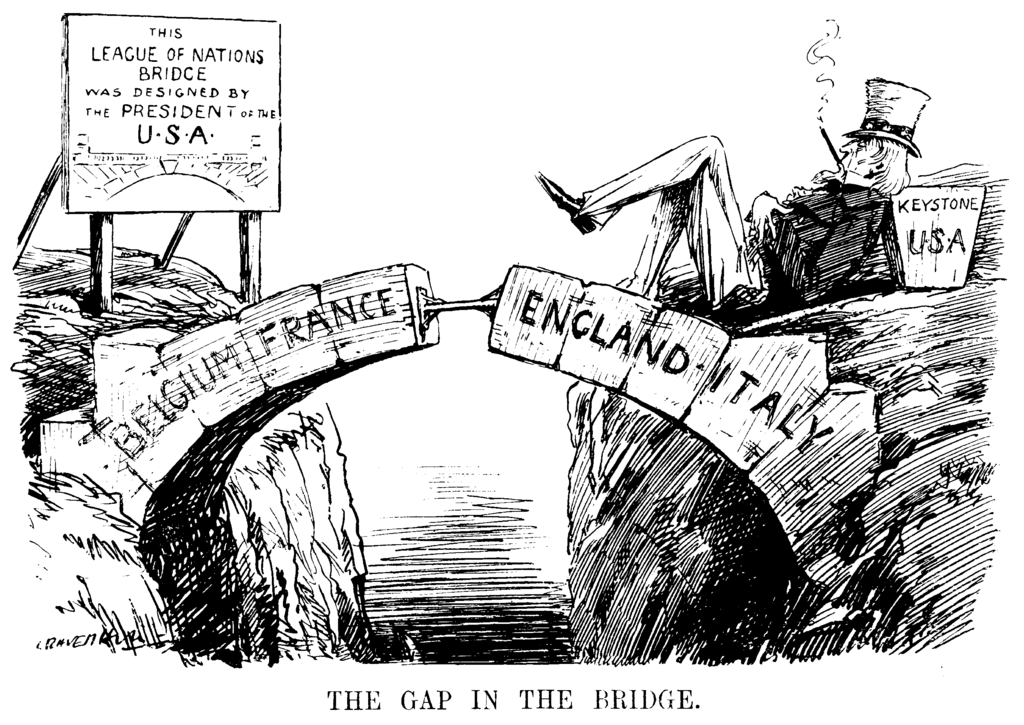
5) Leonard Raven-Hill The Gap in the Bridge' December 10th, 1919; Punch
The refusal of the Republican-dominated US Senate to ratify membership of the League of Nations was a major factor in its failure. President Woodrow Wilson lamented: ‘We had a chance to gain the leadership of the world. We have lost it.’ Without American participation, the League of Nations was doomed to failure. This cartoon by Punch artist Leonard Raven-Hill beautifully represents that.

6) David Low 'Rendezvous', September 20th 1939; Evening Standard
‘Rendezvous’ is New Zealander David Low’s finest cartoon and has been republished more times than any other cartoon in Britain. The Nazi-Soviet Pact of August 1939 stunned the world. Two ideological regimes that had for years seen the other as the true enemy had come together to sign a non-aggression pact. Unknown to the rest of the world, the Germans and Russians also signed a secret protocol which allowed them to divide Poland between them. When they did, as Low later wrote in his autobiography: ‘Hitler divided his opponents and seemingly leaving Britain and France little chance of winning the war. What a situation! In gloomy wrath at missed opportunity and human stupidity I drew the bitterest cartoon of my life.’
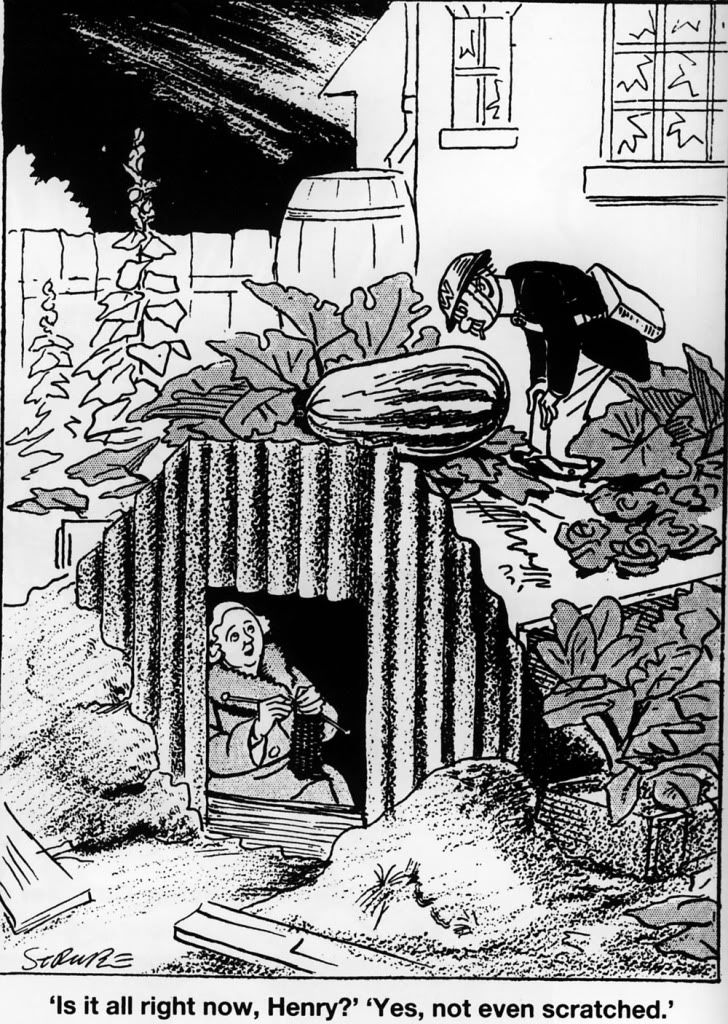
7) Sidney 'George' Strube '"Is it all right now, Henry?""Yes, not even scratched." ' August 29th, 1940; Daily Express
This is Strube’s most famous cartoon. His Little Man’s actions in this cartoon emphasise the phlegmatic approach of the average Brit towards the dangers of the Blitz and the threat of invasion. Over two million Anderson shelters, named after the Home Secretary, Sir John Anderson, were erected and, in true British fashion, made homely with bunks inside and flowers and vegetables planted in the protective bank of earth. However, only those with gardens in which to erect them, less than 25 per cent of the population, benefited from the provision of the Anderson shelter. Coincidentally, an American journalist wrote during the Blitz that ‘there was a greater danger of being hit by a vegetable marrow falling off the roof of an air-raid shelter than of being struck by a bomb’.
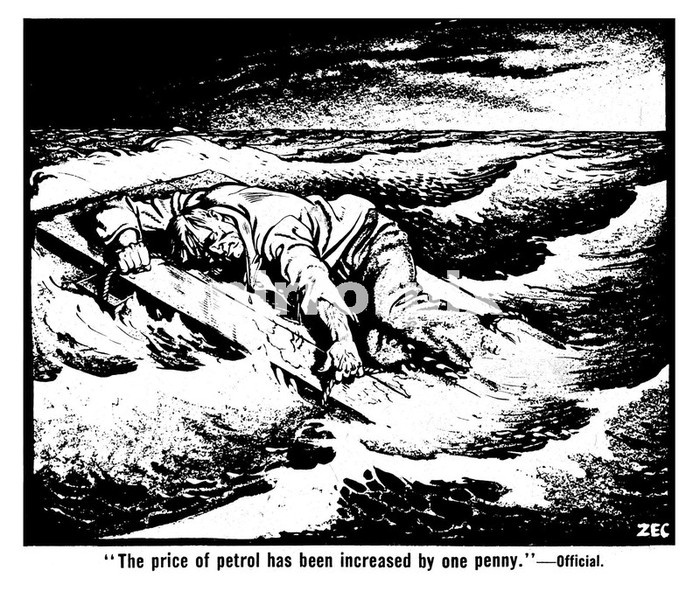
8) Philip Zee '"The Price of Petrol has increased by one peony" - Official', March 1942; Daily Mirror
Prime minister Winston Churchill was furious when the Daily Mirror published this cartoon on the Government’s decision to increase the price of petrol. Churchill believed that the cartoon suggested that merchant seamen’s lives had been put at stake to enhance the profits of the petrol companies. In the House of Commons, Herbert Morrison, the Home Secretary, called it a ‘wicked cartoon’ and ‘worthy of Goebbels at his best’. The Government considered closing down the Daily Mirror but eventually decided to let the newspaper off with a severe reprimand.
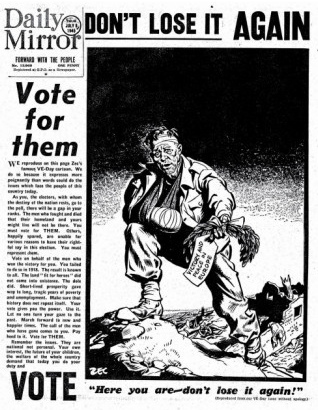
9) Philip Zec 'Here you are! Don't lose it again!' May 8th, 1945; Daily Mirror
One of the strongest images of the Second World War is the Philip Zec cartoon of a bloodied Tommy in the ruins of Europe holding a wreath marked ‘Victory and peace in Europe’. This cartoon appeared in the Daily Mirror on VE Day. It was used again, this time on the front page of the Daily Mirror, on the morning of the 1945 General Election. Next to the cartoon the text suggested that the best way to preserve peace was to vote for the Labour Party. Zec’s VE-Day cartoon summed up the mood of the general public. The Daily Mirror was inspired by a reader’s letter. Mrs C. Gardiner wrote about the hopes she had when her soldier husband returned home, ending with the pledge ‘I shall vote for him’. The paper took up the theme on its front page, with the words: ‘Vote for Him’. The Daily Mirror's editor, Hugh Cudlipp, said that the cartoon did more than any other factor in helping Labour win the 1945 General Election.

10) Vicky 'Introducing: Supermac', November 6th, 1958; Evening Standard
To many, Harold Macmillan’s demeanour as an Edwardian aristocrat seemed completely out of step with the times. The Hungarian-born Vicky ridiculed the then prime minister as ‘Supermac’, a spoof on the American comic-strip hero Superman. Contrary to the cartoonist’s intention, the title Supermac ironically benefited Macmillan as he went on to increase his parliamentary majority at the 1959 General Election. Guardian cartoonist Steve Bell was to have greater success on the same theme, with John Major as a ‘naff’ Superman sporting his Y-fronted underpants outside his trousers. Major once said of this depiction of him: ‘It is intended to destabilise me and so I ignore it.’
Do you agree with me? Is there a brilliant cartoon I have left out? Do let me know.
 View Account
View Account